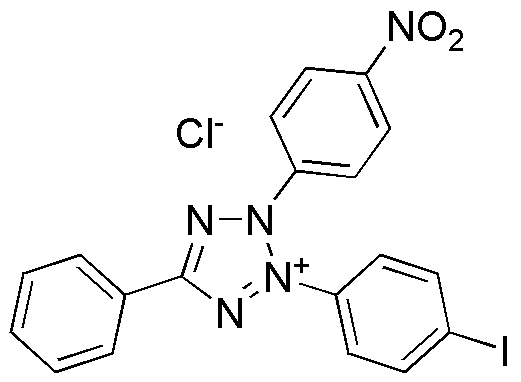4-Iodonitrotetrazolium violet is widely utilized in research focused on:
- Biochemical Assays: This compound serves as a vital reagent in various biochemical assays, particularly for detecting dehydrogenase activity in cells, which is crucial for understanding metabolic processes.
- Histological Staining: It is employed in histology for staining tissues, allowing researchers to visualize cellular structures under a microscope, enhancing the study of pathology.
- Electrochemical Sensors: The compound is used in the development of electrochemical sensors, providing a reliable method for detecting specific analytes in environmental and clinical samples.
- Pharmaceutical Research: In drug development, it aids in screening potential drug candidates by assessing their effects on cellular respiration and viability.
- Colorimetric Analysis: Its color-changing properties make it useful in colorimetric assays, allowing for easy quantification of substances in various chemical analyses.
General Information
Properties
Safety and Regulations
Applications
4-Iodonitrotetrazolium violet is widely utilized in research focused on:
- Biochemical Assays: This compound serves as a vital reagent in various biochemical assays, particularly for detecting dehydrogenase activity in cells, which is crucial for understanding metabolic processes.
- Histological Staining: It is employed in histology for staining tissues, allowing researchers to visualize cellular structures under a microscope, enhancing the study of pathology.
- Electrochemical Sensors: The compound is used in the development of electrochemical sensors, providing a reliable method for detecting specific analytes in environmental and clinical samples.
- Pharmaceutical Research: In drug development, it aids in screening potential drug candidates by assessing their effects on cellular respiration and viability.
- Colorimetric Analysis: Its color-changing properties make it useful in colorimetric assays, allowing for easy quantification of substances in various chemical analyses.
Documents
Safety Data Sheets (SDS)
The SDS provides comprehensive safety information on handling, storage, and disposal of the product.
Product Specification (PS)
The PS provides a comprehensive breakdown of the product’s properties, including chemical composition, physical state, purity, and storage requirements. It also details acceptable quality ranges and the product's intended applications.
Certificates of Analysis (COA)
Search for Certificates of Analysis (COA) by entering the products Lot Number. Lot and Batch Numbers can be found on a product’s label following the words ‘Lot’ or ‘Batch’.
*Catalog Number
*Lot Number
Certificates Of Origin (COO)
This COO confirms the country where the product was manufactured, and also details the materials and components used in it and whether it is derived from natural, synthetic, or other specific sources. This certificate may be required for customs, trade, and regulatory compliance.
*Catalog Number
*Lot Number
Safety Data Sheets (SDS)
The SDS provides comprehensive safety information on handling, storage, and disposal of the product.
DownloadProduct Specification (PS)
The PS provides a comprehensive breakdown of the product’s properties, including chemical composition, physical state, purity, and storage requirements. It also details acceptable quality ranges and the product's intended applications.
DownloadCertificates of Analysis (COA)
Search for Certificates of Analysis (COA) by entering the products Lot Number. Lot and Batch Numbers can be found on a product’s label following the words ‘Lot’ or ‘Batch’.
*Catalog Number
*Lot Number
Certificates Of Origin (COO)
This COO confirms the country where the product was manufactured, and also details the materials and components used in it and whether it is derived from natural, synthetic, or other specific sources. This certificate may be required for customs, trade, and regulatory compliance.


